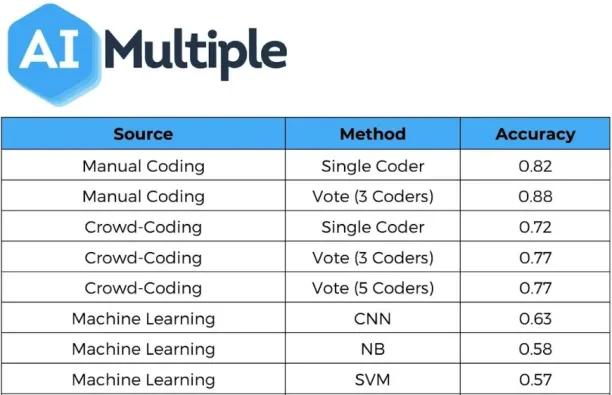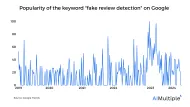Crowdsourcing Sentiment Analysis in 2024
“There is too much data but too little time.”
– Jeanine Evers, Qualitative Researcher at Erasmus University Rotterdam.
As consumer data grows exponentially, it becomes challenging to analyze all of it. So, companies started to use machine-based algorithms to understand their customers’ feelings and thoughts. However, research shows that even though automated methods save time and money for some projects, manually labeling and analyzing the data results in more accurate classifications for others.
To understand consumers’ feelings and thoughts, sentiment analysis is required; however, manual labeling of all consumer data can be labor-intensive and expensive if performed in-house. Many business leaders opt for crowdsourcing methods to mitigate these issues and maintain a high labeling accuracy.
This article examines manual and automated sentiment analysis methods, their strengths and weaknesses, and introduces an alternative method that can compensate for their inadequacies: Crowd-sourcing sentiment analysis.
Figure 1. A comparison of manual, automated, and crowdsourcing sentiment analysis and their accuracy scores

Manual Sentiment Analysis
Companies can identify the intention behind consumers’ reviews, feedback, or texts by manually labeling the terms based on their emotional tone and understanding the sentiment behind texts.
Pros
- Provides in-depth analysis and the most accurate results.
- Differentiates linguistic nuances such as sarcasm, irony, or slang.
- Assess the complexity behind texts.
Cons
- Takes a great amount of time.
- It is expensive.
- It may include the annotator’s bias.
Automated Sentiment Analysis
As manually labeling the data requires great effort and is time-consuming, companies also use machine learning algorithms to train their dataset and reduce costs. Automated methods extract the relevant data and label the texts based on their emotional tones.
Pros
- It is cost-efficient and not labor-intensive.
- Reduces bias in the results.
- Automated methods provide inclusive and consistent data analysis due to the possibility of data being overlooked in the manual analysis method due to fatigue.
Cons
- Provides misleading results when the dataset in one domain is used to train the algorithm in another discipline.
- Does not differentiate emojis, slang, sarcasm, or irony. However, emerging technologies started to implement features that can identify language nuances.
- Requires a large number of data to have high accuracy scores.
- Has a learning curve.
- Needs manually coded training data.
Figure 2. The learning curve of machine learning algorithms
What is crowdsourcing sentiment analysis, and what are its benefits of it?
Crowdsourcing is a method that has become popular, especially in recent years, and it includes paid workers or volunteers who complete a range of tasks to solve specific problems. As there is human involvement, crowdsourcing methods provide higher accuracy scores regarding consumers’ sentiments.
What are the benefits of crowdsourcing sentiment analysis?
- It is more transparent.
- It provides more accurate results than automated methods, especially in the fields that require subjective decisions such as classifying emotions.
- It can reduce ambiguity as different people can evaluate the same content.
Figure 3. The benefits of crowdsourcing
Check our data-driven list of sentiment analysis services to find out which option satisfies your company’s needs.
Please contact us if you have any additional questions about sentiment analysis:

Cem has been the principal analyst at AIMultiple since 2017. AIMultiple informs hundreds of thousands of businesses (as per similarWeb) including 60% of Fortune 500 every month.
Cem's work has been cited by leading global publications including Business Insider, Forbes, Washington Post, global firms like Deloitte, HPE, NGOs like World Economic Forum and supranational organizations like European Commission. You can see more reputable companies and media that referenced AIMultiple.
Throughout his career, Cem served as a tech consultant, tech buyer and tech entrepreneur. He advised businesses on their enterprise software, automation, cloud, AI / ML and other technology related decisions at McKinsey & Company and Altman Solon for more than a decade. He also published a McKinsey report on digitalization.
He led technology strategy and procurement of a telco while reporting to the CEO. He has also led commercial growth of deep tech company Hypatos that reached a 7 digit annual recurring revenue and a 9 digit valuation from 0 within 2 years. Cem's work in Hypatos was covered by leading technology publications like TechCrunch and Business Insider.
Cem regularly speaks at international technology conferences. He graduated from Bogazici University as a computer engineer and holds an MBA from Columbia Business School.
To stay up-to-date on B2B tech & accelerate your enterprise:
Follow on
Comments
Your email address will not be published. All fields are required.